


|
February 2011 New from Flesk Publications: Harvey Dunn: Illustrator and Painter of the Pioneer West  |
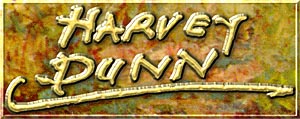 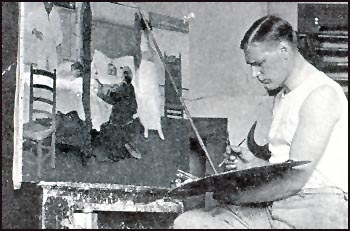 |
Issues #2, 8 & 9 feature Harvey Dunn artwork. and he's in #3 of |
Harvey Thomas Dunn was born in 1884 on the Dakota prairies where he lived on his parents' homestead until he was 17. He was a large boy who was capable of doing a man's job by the age of 14. It's a wonder that he had time for schooling, farm work and drawing. He did all three remarkably well and in 1901 he left the farm to enroll at South Dakota Agriculture College. It was there he met a young art teacher named Ada B. Caldwell who quickly recognized his talent and recommended that he continue his studies at the Chicago Art Institute.
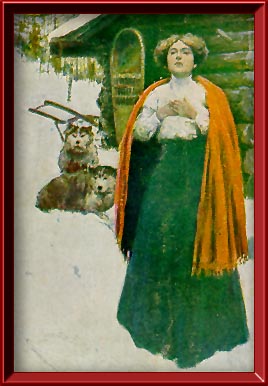
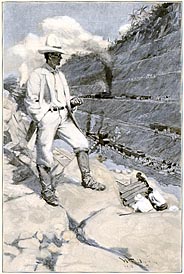 In 1902,
in his only suit and toting his belongings in a trunk, the lanky
farm boy set off for the dizzying sophistication of Chicago. He
earned his tuition doing odd jobs and janitor work and as a farm
hand during the summer. He drew and he painted and he convinced
a school of disbelievers that the hick from the prairie was an
artist. At the age of 20, he convinced Howard Pyle of his talent and was accepted
into the master's classes at Wilmington and Chadd's Ford.
In 1902,
in his only suit and toting his belongings in a trunk, the lanky
farm boy set off for the dizzying sophistication of Chicago. He
earned his tuition doing odd jobs and janitor work and as a farm
hand during the summer. He drew and he painted and he convinced
a school of disbelievers that the hick from the prairie was an
artist. At the age of 20, he convinced Howard Pyle of his talent and was accepted
into the master's classes at Wilmington and Chadd's Ford.
By 1906, he was on his own, making a living in the burgeoning and competitive world of commercial illustration and selling his art to the insatiable magazine markets of the day. At right is an early illustration for Scribner's in 1907. At left is the color cover plate (which was reproduced in b&w as the frontispiece of the book) to Rex Beach's The Silver Horde from 1909. The Pyle influence is strong, just as it was in classmates Frank Schoonover and N.C. Wyeth.
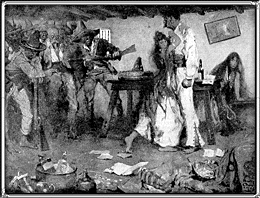 He
married in 1908 (Wyeth was his best man) and settled into a career
both daunting and prodigious. He painted with a spirited zeal
that gave his work great power and left his editors in awe of
his speed. After Pyle died in 1911, Dunn left Wilmington for Leonia,
New Jersey, to be closer to his New York markets. The Saturday
Evening Post was one of his best clients. The image at right
is from a 1916 issue (the original is owned by the South Dakota
Art Museum. Used with their permission.)
He
married in 1908 (Wyeth was his best man) and settled into a career
both daunting and prodigious. He painted with a spirited zeal
that gave his work great power and left his editors in awe of
his speed. After Pyle died in 1911, Dunn left Wilmington for Leonia,
New Jersey, to be closer to his New York markets. The Saturday
Evening Post was one of his best clients. The image at right
is from a 1916 issue (the original is owned by the South Dakota
Art Museum. Used with their permission.)
Inspired by Pyle's example, Dunn opened the Leonia School
of Illustration in 1915 with artist Charles S. Chapman. Dean Cornwell, who attended
the classes for the few years the school existed, said, "I
gratefully look back on the time when I was privileged to sit
at Harvey Dunn's feet . . . [he] taught art and illustration as
one. He taught it as a religion - or awfully close to such."
![]() Chapman and Dunn turned out to be incompatible
partners and disbanded the school, but not before Dunn was convinced
that teaching was his passion and his destiny. World War I postponed
things.
Chapman and Dunn turned out to be incompatible
partners and disbanded the school, but not before Dunn was convinced
that teaching was his passion and his destiny. World War I postponed
things.
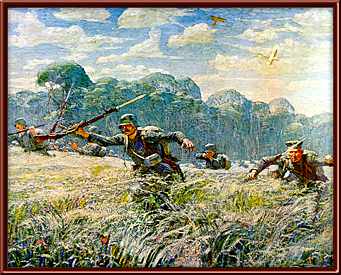 Dunn
was 33 in 1917 and past the age of military service, but he was
chosen as one of a cadre of eight artists who were commissioned
to serve as graphic reporters of combat activities at the front.
He was a fearless reporter and filled scrolls with powerful images
of devastation, both physical and emotional. He wanted desperately
to transform these reams of drawings into finished paintings and
expected to be kept on the national payroll as he completed the
proposed canvases. But he was discharged in 1919 immediately after
the war and had to return to commercial work to support himself
and his family. It was a bitter disappointment. His drawings still
exist, many at the Smithsonian, and display an emotional power
that still can overwhelm the viewer, even today.
Dunn
was 33 in 1917 and past the age of military service, but he was
chosen as one of a cadre of eight artists who were commissioned
to serve as graphic reporters of combat activities at the front.
He was a fearless reporter and filled scrolls with powerful images
of devastation, both physical and emotional. He wanted desperately
to transform these reams of drawings into finished paintings and
expected to be kept on the national payroll as he completed the
proposed canvases. But he was discharged in 1919 immediately after
the war and had to return to commercial work to support himself
and his family. It was a bitter disappointment. His drawings still
exist, many at the Smithsonian, and display an emotional power
that still can overwhelm the viewer, even today.

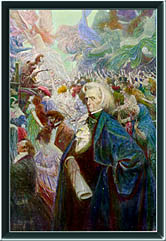 Settling back into
the illustrative grind was simply not as satisfying as it had
been before his war experiences. He moved to Tenefly, New Jersey,
in 1919 and built a large studio adjacent to his new home. More
and more he felt the need to create lasting art, in addition
to illustration. He was commissioned to paint five mural-like
panels for the 100th anniversary of a New York department store
in 1925, but this failed to supply him with the fulfillment he
sought.
Settling back into
the illustrative grind was simply not as satisfying as it had
been before his war experiences. He moved to Tenefly, New Jersey,
in 1919 and built a large studio adjacent to his new home. More
and more he felt the need to create lasting art, in addition
to illustration. He was commissioned to paint five mural-like
panels for the 100th anniversary of a New York department store
in 1925, but this failed to supply him with the fulfillment he
sought.
In 1928 a venue opened up for Dunn to complete several of his proposed war canvases. The American Legion Monthly magazine began to feature his paintings as covers and Dunn's vision of the war was recorded for posterity. There were still two other goals yet to be reached: teaching and capturing the beauty of his native Dakotan prairie. The Legion magazine covers allowed him a venue for the latter and teaching was never far from his thoughts. Pyle's legacy would never find a more ardent supporter nor capable disciple.
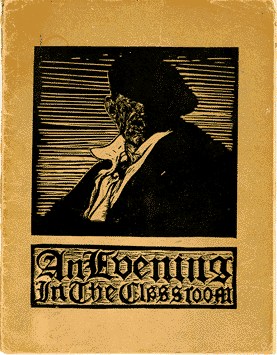 Dunn
taught. It was part of his life. He taught at the Grand Central
School of Art, at the Art Students League in New York,
and in his studio for select advanced students. His classes were
popular and productive. Pyle would have been proud. His students
included: Cornwell,
Harold von Schmidt,
Saul Tepper, John Clymer, Lyman Anderson, James E. Allen, Mario
Cooper, and others. In 1934, the legendary teacher was captured
in print in An Evening in the Classroom - being notes
taken by Miss Taylor in one of the classes on painting conducted
by Harvey Dunn and printed at the instigation of Mario Cooper.
Printed in an edition of only 1000 and filled with striking woodcuts,
Dunn provided critiques on student's paintings that are not reproduced.
Still his comments there form a record of his beliefs and his
cogent teaching methods.
Dunn
taught. It was part of his life. He taught at the Grand Central
School of Art, at the Art Students League in New York,
and in his studio for select advanced students. His classes were
popular and productive. Pyle would have been proud. His students
included: Cornwell,
Harold von Schmidt,
Saul Tepper, John Clymer, Lyman Anderson, James E. Allen, Mario
Cooper, and others. In 1934, the legendary teacher was captured
in print in An Evening in the Classroom - being notes
taken by Miss Taylor in one of the classes on painting conducted
by Harvey Dunn and printed at the instigation of Mario Cooper.
Printed in an edition of only 1000 and filled with striking woodcuts,
Dunn provided critiques on student's paintings that are not reproduced.
Still his comments there form a record of his beliefs and his
cogent teaching methods.
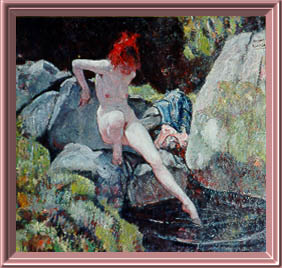
(from the Kelly Collection of American Illustration, used with permission.)
He made many trips back to South Dakota and painted his memories and the stories of the land from the sketches he made. Very few of these "prairie paintings" saw print, but in 1950 he donated 42 of them to the South Dakota State College (now the South Dakota State University), where he had studied under Ada B. Caldwell, back when it was called the Agricultural College. This collection has grown to over 90 canvases and remains on display to this day at the South Dakota Art Museum, where they were transferred in 1970.
Two years later, Dunn died in 1952. His New York Times obituary was headed:
Harvey Dunn, 68Artist, Teacher

To learn more about Harvey Dunn, see:
| An Evening in the Classroom | Miss Taylor, 1934 Harvey Dunn |
| Forty Illustrators and How They Work | Ernest W. Watson, 1946 Watson-Guptill |
| The Prairie is My Garden | Robert K. Karolevitz, 1969 North Plains |
|
|
Robert K. Karolevitz, 1970 North Plains |
| Step-By-Step Graphics vol. 5 #3 | Charles J. Andres, 1989 Dynamic Graphics |
| Harvey Dunn: Illustrator and Painter of the Pioneer West | Walt Reed, 2011 Flesk Publications |
| The Vadeboncoeur Collection of Knowledge | Jim Vadeboncoeur, Jr. 1998 |
| The Vadeboncoeur Collection of ImageS 2, 8, 9, B&W ImageS 3 | Jim Vadeboncoeur, Jr. 2001, 2006, 2007, JVJ Publishing |
|
Illustrations are copyright by their respective owners. This page written, designed & © 1998 by Jim Vadeboncoeur, Jr. Updated 2011. |
